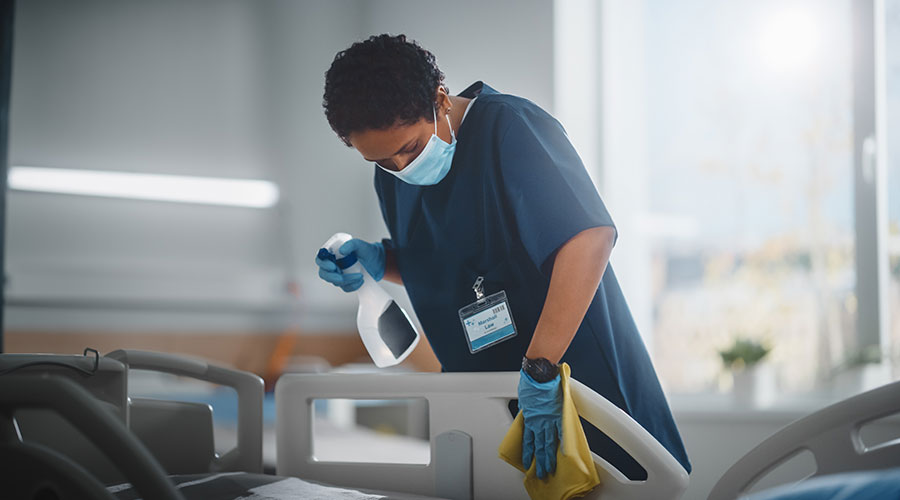Globally, a group of pathogens — Enterococcus faecium, Staphylococcus aureus, Klebsiella pneumoniae, Acinetobacter baumannii, Pseudomonas aeruginosa and Enterobacter species (ESKAPE) — are the major cause of healthcare-associated infections (HAI).
When headlines in the patient safety guide tout that HAIs have decreased in U.S. hospitals, one must wonder whether officials are counting all pathogens of concern or just a select few. In 2023, a multistate, point-prevalence survey involving 183 U.S. hospitals reported that four percent of hospitalized patients developed an HAI, with Clostridium difficile and ESKAPE pathogens being the most frequently isolated.
Hospitals and other healthcare facilities can serve as reservoirs for antimicrobial-resistant (AMR) ESKAPE pathogens, allowing these opportunistic pathogens to spread from hospital environments to inpatients or occasionally to the community via the movement of individuals in and out of facilities.
In fact, recent epidemiological studies have confirmed the prevalence of S. aureus, Acinetobacter baumannii and P. aeruginosa on various hospital surfaces, including bed rails, armrests and nurse call buttons, which are all found in intensive care units and are frequently touched by medical practitioners.
Despite the compliance of current surface disinfection and cleaning programs, ESKAPE pathogens continue to be isolated from the hospital environment. For example, a recent study found that 27 percent of hospital rooms remained contaminated with A. baumannii or methicillin-resistant S. aureus (MRSA) following four rounds of bleach disinfection.
The failure of such methods to eliminate surface contamination might be due to the high resistance of bacterial cells to these adverse conditions as an evolutional consequence or to the adoption of unique survival strategies, such as biofilm formation and encapsulation.
While environmental services technicians cannot fully eradicate ESKAPE pathogens, timely interventions can mitigate their impact. Bacteria replicate rapidly, with some species doubling their population every 20 minutes. Effective measures must outpace this rapid bacterial growth.
Environmental service technicians play an essential role in preventing HAIs. Recent studies have found significant improvements in cleaning by using interventions directed at technicians. For optimal effectiveness, these interventions require that technicians be knowledgeable about the prevention and transmission of disease and well-trained in the best practices that keep patients safe.
The rising threat of AMR pathogens demands immediate, unwavering action. Managers must adopt a "whatever it takes" stance, rather than questioning the costs. The stakes are too high to allow patient rooms to be cleaned by a technician who is not knowledgeable about the role of cleaning in breaking the chain of infection.
Technicians must be properly compensated, regarded as a part of the facility’s multi-modal infection prevention program, be well-trained in the nuances of cleaning and disinfection, allotted the time to do the necessary tasks, equipped with the best in class tools to clean and disinfect surfaces and educated about the prevention and transmission of disease.
J. Darrel Hicks, BA, MESRE, CHESP, Certificate of Mastery in Infection Prevention, is the past president of the Healthcare Surfaces Institute. Hicks is nationally recognized as a subject matter expert in infection prevention and control as it relates to cleaning. He is the owner and principal of Safe, Clean and Disinfected. His enterprise specializes in B2B consulting, webinar presentations, seminars and facility consulting services related to cleaning and disinfection. He can be reached at darrel@darrelhicks.com, or learn more at www.darrelhicks.com.

 Building Sustainable Healthcare for an Aging Population
Building Sustainable Healthcare for an Aging Population Froedtert ThedaCare Announces Opening of ThedaCare Medical Center-Oshkosh
Froedtert ThedaCare Announces Opening of ThedaCare Medical Center-Oshkosh Touchmark Acquires The Hacienda at Georgetown Senior Living Facility
Touchmark Acquires The Hacienda at Georgetown Senior Living Facility Contaminants Under Foot: A Closer Look at Patient Room Floors
Contaminants Under Foot: A Closer Look at Patient Room Floors Power Outages Largely Driven by Extreme Weather Events
Power Outages Largely Driven by Extreme Weather Events